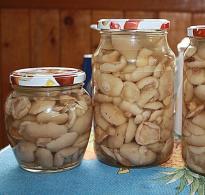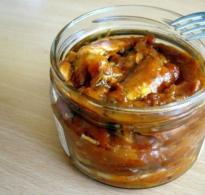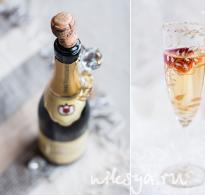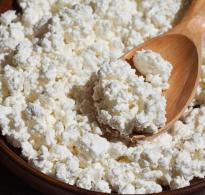Homemade panko crackers. Japanese panko croutons - homemade recipe
Japanese cuisine is popular not only due to its exoticism - it is fundamentally very healthy. But, besides the “familiar” seafood dishes, Japanese cuisine has many lesser-known, but no less tasty things. Panko croutons– one of the typical representatives of traditional Japanese cuisine.
The name of these delicious crackers appeared after contacts between Japanese residents and Portuguese sailors. "Panko" is the Portuguese word for "bread" (from a common Latin root, compare with "breading") to which the Japanese ending "ko" ("crumbs") was added. Panko breadcrumbs have several noticeable differences from our breadcrumbs:
- panko is more reminiscent of air flakes - in texture and shape, as opposed to denser crackers;
- Our favorite crusts in Japanese crackers are necessarily cut off and not used;
- Breadcrumbs are significantly smaller in size than panko.
There are two types of crackers in this photo. Now you can clearly see all these differences. (Try to guess where the panko is.)

When deep-frying, panko crackers absorb less oil than regular breadcrumbs (precisely due to their airiness). So, it turns out that their use, in addition to everything else, also makes the dish more useful and healthy.
To make crackers you only need one ingredient: yesterday's loaf of white yeast bread

We wrap several slices of loaf (sliced, which is very convenient) with cling film.

Place them in the freezer for at least three hours.

We take out the bread, unwrap it and cut off the crusts.

Cut the bread into large cubes.

Using a blender, in pulse mode (pressing and releasing), grind the bread into crumbs.
Attention: we grind in small portions! Do not put all the bread into the blender at once!
We do this: literally press the button for a second. Let it go and shake the bowl so that the bread inside is evenly distributed. Then we press again, release, shake, etc.

This way the bread will not be ground into very fine crumbs, but you will get just the desired flakes.
Cover the baking tray with baking paper and spread bread crumbs in an even layer.

Place in the oven to dry at minimum temperature. At the same time, you can also keep the oven door slightly open.
The crackers should not change color, but simply dry out. Therefore, every 2-3 minutes we take out the baking sheet and mix them carefully. If there are still large pieces of bread left, just at this moment you can crush them with your fingers.

It’s difficult to say exactly how long it takes to dry. It all depends on your oven. Once the crackers are completely dry, take them out and cool.

Store panko in a tightly closed container in the refrigerator. Then the shelf life increases, and the crackers will stay there for several weeks without any problems.

You can use panko crackers both for breading when frying and for sprinkling when baking.

Text: Elena Elliott (photo can be easily found on various Arabic sites)
There are many recipes for making panko breadcrumbs. Of course, you can buy these breadcrumbs, but why pay extra when you can put in very little effort and get beautiful homemade ones.
Let's first figure out what kind of crackers these are?
Panko is a traditional Japanese breading mixture for deep frying.
The name panko consists of two words: “pan” - translated from Portuguese as “bread” and “ko” - translated from Japanese as “powder”, “flour”. These crackers are made from crustless bread. This effect is achieved by passing an electric current through plastic or wooden molds with dough. Such bread quickly becomes stale, after which it is ground so that fine crumbs are obtained. They are saturated with oxygen, which makes them airy and light. Panko adds fluffiness and a beautiful appearance to dishes.
To make crackers, we need yesterday's loaf.
Let's start cooking:
1. Cut the loaf into slices or take a sliced loaf. Wrap each slice in cling film and place in the freezer for at least 3 hours.

2. After 3 hours, take out the loaf, unwrap it and cut off the crusts.
3. Cut into large cubes.
4. Grind the bread in small portions in a blender. You should end up with smaller crumbs, more like flakes. To achieve this, you need to grind as follows: grind for 1-2 seconds, shake, grind again, and so on until you get crackers of the desired size.
5. Line a baking sheet with parchment and place the crumbs in one layer.

6. Place the baking sheet in the oven over low heat. Gently stir the crackers every 2-3 minutes. They should dry out, but not fry.
7. When the crackers become dry, remove them from the oven and cool.
8. Store in a tightly closed container in the refrigerator. Panko breadcrumbs will keep for several weeks in this state.
Bon appetit!
How something “European” turns into “truly Japanese”
For a long time, Japan remained a country closed to foreigners, the only exception being the Portuguese monks and merchants who supplied Chinese silk to the islands. They also brought some culinary traditions. It is no coincidence that the word for “bread” in Japanese is “pan” - a literal borrowing from Portuguese. Therefore, “panko” in Japanese is a flour made from bread crumbs.

Panko breading is large bread crumbs that look like shavings.
No, the Japanese have not become less Japanese since then, and their “bread” is still rice in the form of porridge, noodles, flour, and lumps of sushi. But breading in their kitchen has taken root and changed somewhat, becoming truly Japanese, and has been traveling in the culinary world for a long time. It is actively produced and used in the countries of Southeast Asia (China, Korea, Thailand, Vietnam), as well as in the USA.
Panko owes its popularity primarily to the volume of the breading. The crackers resemble shavings and stick to each other like snow crystals. The classic mixture is silvery, white, airy, since dark bread crusts are not used in its creation. After deep-frying, products (meat, shrimp, fish, vegetables) become fluffy and golden, crispy well, a juicy filling is formed inside, and the top layer absorbs little fat.
What's in Japanese breading now? – Colorful, textured presentation of the dish, at the same time simple and elegant, preserving the natural taste of the products inside.
Panko breaded shrimp
Panko is always a little more than just breadcrumbs
For their breading, the Japanese make special bread from wheat flour with a high protein content. The dough should be fibrous and airy. It is the presence of air bubbles and a high level of gluten that makes it possible to create a larger and more textured crumb. The bread is baked in the form of large rectangular layers in special electric ovens. The main thing is that there is no dark crust, so it is removed from the oven before it begins to brown.
The finished bread is dried under natural conditions for about 18 hours, placed in paper bags, and then crushed and packaged in large bags for restaurants or in small bags for home cooking.
Panko breading production: bread baking and drying in natural conditions
Besides authentic Japanese panko, there are other options for producing and using these breadcrumbs:
Various spices are added to the breading: black pepper, turmeric, curry.
For some Asian dishes, as well as for desserts, a mixture of panko with coconut flakes and sugar is used. This blend is sometimes called "Caribbean" if it contains rum aromas.
In Mediterranean dishes, the bread mixture is mixed with grated Parmesan, olive oil, oregano, basil, rosemary and other Italian herbs.
Sprinkling with the addition of various seeds looks very impressive: sesame, flax, sunflower.

Panko with spices, herbs, seeds
An invention made by Japanese soldiers during World War II has received a second life in modern America. Panko breadcrumbs are now in the pantry of one in six American households. Panko is gradually making its way into our kitchen.
During the war, the Japanese adapted to bake bread using electricity obtained from tank batteries. Homemade electric furnaces in combat conditions had an important advantage: they did not smoke, which means they did not attract the attention of the enemy.
The bread that came out of such ovens was also unusual: it did not have a crispy crust, but the entire crumb was baked evenly. Electric ovens, built on this principle already in peacetime, now bake bread for bread crumbs - panko. In Japan, not a single restaurant or family can do without panko. As a rule, this breading is white in color and does not have any pronounced taste.
Panko grains are larger than American or European bread crumbs, and because of their needle-like structure, Japanese bread crumbs have the ability to add volume. Let's say a small shrimp coated in panko seems very large when fried. Because of this property, panko is especially loved by Japanese chefs. In addition, Japanese breading does not absorb vegetable oil as intensively during frying as regular breading, but it has a crispier taste.
The latter feature attracts increased attention from American manufacturers, who indulge their compatriots’ passion for chicken fingers and other fast food that requires deep frying in oil; and, at the same time, the fashion for healthier food: panko does not need to be kept in boiling oil for a long time, they are already crunchy.
The popularity of Japanese babes naturally came from TV shows. The champion in this matter is Rachel Ray's program on the Food Network, writes The Wall Street Journal. The publication quotes a representative from the food giant Kraft Foods: panko leads a group of three products whose popularity in the American market is growing at a particularly rapid pace. The other two foods are tilapia fish and brown rice.
It is clear that the delights (as well as the harm, which you have probably read about) of tilapia, as well as brown rice, are not so much the result of the forces of nature that produce them, but rather of marketing technologies. However, in the case of panko, the story is all the more interesting because we are talking about technologies invented by Japanese soldiers who fought with the Americans.
But marketing technology is a terrible force. The product of the Japanese military, as Soviet newspapers would call it, is perceived in America as local. Moreover, the Americans have developed the idea and produce panko with different flavoring additives, giving the bread crumbs different tastes, from Italian to Mexican smoked chipotle peppers.
For now, I’m quite happy with regular Japanese bread crumbs, for which I keep finding new uses. Without looking too far for examples, here is a recipe where I used panko to make crispy zucchini (
Japanese chef with 30 years of experience, Kiyoshi Hayamizu, shared the secrets of preparing the national Japanese dish - tempura.
Japanese breadcrumbs differ from European ones in shape - they are larger and airier.
The seasoning is used for deep-frying rolls, vegetables, meat and seafood.
Panko adds fluffiness to foods and a more beautiful appearance to dishes. The light and airy texture of the breading allows excess oil to easily drain, making dishes less greasy.
The recipe is simple: first dip the product in tempura batter, roll in panko, and deep-fry.


For breaded dishes, two types of sauces are suitable: ketchup or mayonnaise.
1. Mix ketchup with soy sauce. You can add a couple of drops of Tabasko, or mustard, or curry seasoning to taste.

2. Mix mayonnaise with soy sauce and mustard. Add finely chopped gherkins, a boiled egg, chopped onion (first fill the onion with water, squeeze, add water again and squeeze again) and parsley. Mix everything. If the sauce is too thick, thin it with liquid from a jar of gherkins.


- Subscribe to our telegram channel






